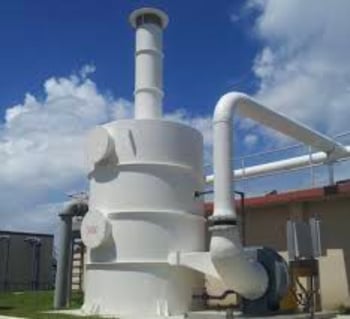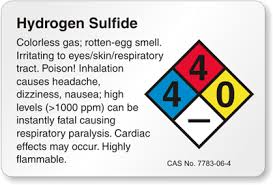 Odor control and acid scrubbers are both popular in many industries.
Odor control and acid scrubbers are both popular in many industries.
Their focus is on treating gases that require deodorization and corrosion protection. When choosing a system for a project, it is important to consider several key factors.
To make an informed decision, familiarize yourself with the article "Industrial Odor Control: The Do's and Don'ts." It provides valuable insights into odor control scrubbers and their operational challenges.
Identify the source of the off-gas or odor problem.
Determine if it is corrosive, dangerous, or emits a noxious odor. These are the first steps in the selection process.
Hiring a design expert is crucial to ensure a comprehensive analysis of the gas airflow. The evaluation should identify any dangerous elements like ammonia (NH3), hydrogen sulfide (H2S), or caustic (NaOH) that may lead to corrosion. It is essential to pinpoint the source of the unpleasant or corrosive gas during the planning and decision-making process.
To select the right odor control treatment method for odorous gas, it is essential to understand the gas's characteristics and origin. This knowledge will help decide the best approach.
Water treatment plants, industrial wastewater treatment plants, and industrial water treatment plants can all generate this. Manufacturing processes and collection systems, such as lift stations and headworks facilities, can also generate this. Knowing the source of the odorous gas is key to determining the best treatment method.
Hydrogen sulfide (H2S) is often the main odorous gas produced from water treatment processes.
It poses a triple threat as it is corrosive, dangerous, and noxious. Hydrogen sulfide gas (H2S) may be present in a water source. In such cases, treatment methods involving reagent chemicals, like caustic, may be necessary.
 Hydrogen sulfide gas (H2S) is a hazardous gas that is colorless, flammable, and toxic. It has a strong odor of rotten eggs and is heavier than air.
Hydrogen sulfide gas (H2S) is a hazardous gas that is colorless, flammable, and toxic. It has a strong odor of rotten eggs and is heavier than air.
Therefore, it tends to accumulate in low-lying areas. It is highly corrosive and can cause serious health effects, including difficulty breathing, nausea, headaches, and even death. In addition, it can cause damage to metals, rubber, and other materials when exposed to hydrogen sulfide.
Hydrogen sulfide gas is commonly present in industrial environments like oil and gas refineries, paper mills, and wastewater treatment plants. Natural sources like hot springs, geysers, and regions with volcanic activity have hydrogen sulfide.
It is essential to take safety measures when handling hydrogen sulfide gas. This gas is highly toxic and flammable.
Inhaling large concentrations of it can lead to serious health issues, even death. It is also corrosive and can damage metals and other materials. For these reasons, it is important to take the necessary safety precautions when working with hydrogen sulfide gas.
It is important to remember that H2S is hazardous to human health.
Therefore, it is essential to remove it from the water source to make it safe for drinking.
Now let's delve into acid scrubbers, which are a specific type of process scrubber utilized in various industries. Acid fume scrubbers trap acid fumes emitted from the upper parts of process tanks.
This is especially important in industries such as semiconductor production. The purpose of these scrubbers is to protect the environment from these fumes. The scrubbers work to neutralize these fumes.
Fume scrubbers use an acid solution to neutralize gases. These gases come from a caustic tank or a process involving caustic solutions. Scrubbers often use vertical or horizontal packed bed configurations. Their main goal is to neutralize corrosive gases, not just control odors.
Identifying the origin of malodorous or corrosive gas is crucial when designing and choosing materials. Selecting the optimal technology for gas treatment is challenging when the origin and location of the gas are unknown.
Recording the strength and uniformity of the odor pollutants requiring remediation is equally essential. Advances in artificial intelligence can help integrate predictive capabilities into process systems. However, it is essential to have a thorough understanding of concentration levels before choosing an odor control system.
Selecting the wrong treatment process for an odorous gas stream can lead to suboptimal performance and higher operational costs.
A headworks facility can utilize a system for controlling biological odors. Concentration levels at this facility can fluctuate and spike throughout the day or week. This can lead to breakthrough emissions.
Biological odor control scrubbers rely on bacteria beds and colonies to consume organic or inorganic contaminants. However, rapid increases in gas concentrations may overwhelm the bacteria, allowing untreated odorous gas emissions to escape the scrubber.
It is vital to understand the limitations of different systems. We should consider modifications, such as increasing colony density on the media bed or choosing a chemical scrubber. This will ensure effective treatment and minimize operational costs.
Treating hydrogen sulfide gas (H2S) requires special attention. H2S is both odorous and corrosive. For optimal cost-effectiveness, it is advisable to employ two distinct types of scrubbers for odor and gas control. Moreover, it is crucial to exercise caution when regulating the pH levels of the scrubber's recirculation system and blowdown waste stream.
It is advisable to reach out to professionals specializing in odor control systems for expert guidance. By contacting DeLoach Industries Inc. (941) 371-4995, you can gain knowledge on various scrubber options. Their proficiency can aid in choosing the optimal system for your unique requirements and guaranteeing effective and dependable performance.
Proper and safe handling of toxic chemicals and fumes is crucial. ASC publications provide useful information and materials on managing and regulating odor control.




